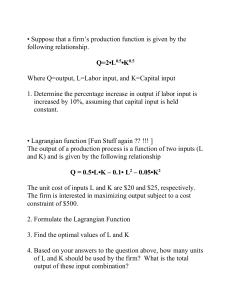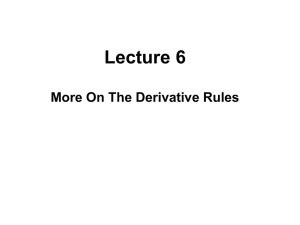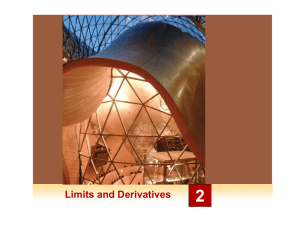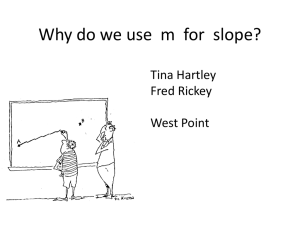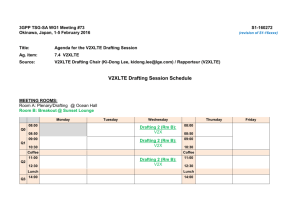General Physics – ph 211
advertisement
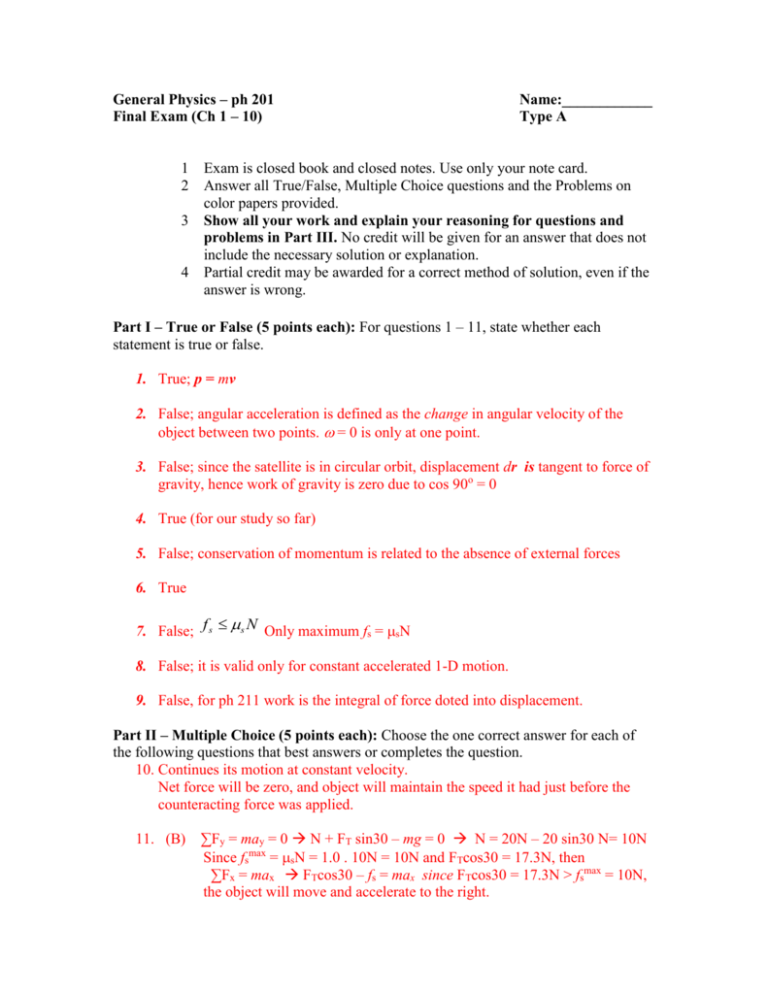
General Physics – ph 201 Final Exam (Ch 1 – 10) 1 2 3 4 Name:____________ Type A Exam is closed book and closed notes. Use only your note card. Answer all True/False, Multiple Choice questions and the Problems on color papers provided. Show all your work and explain your reasoning for questions and problems in Part III. No credit will be given for an answer that does not include the necessary solution or explanation. Partial credit may be awarded for a correct method of solution, even if the answer is wrong. Part I – True or False (5 points each): For questions 1 – 11, state whether each statement is true or false. 1. True; p = mv 2. False; angular acceleration is defined as the change in angular velocity of the object between two points. = 0 is only at one point. 3. False; since the satellite is in circular orbit, displacement dr is tangent to force of gravity, hence work of gravity is zero due to cos 90o = 0 4. True (for our study so far) 5. False; conservation of momentum is related to the absence of external forces 6. True 7. False; f s s N Only maximum fs = sN 8. False; it is valid only for constant accelerated 1-D motion. 9. False, for ph 211 work is the integral of force doted into displacement. Part II – Multiple Choice (5 points each): Choose the one correct answer for each of the following questions that best answers or completes the question. 10. Continues its motion at constant velocity. Net force will be zero, and object will maintain the speed it had just before the counteracting force was applied. 11. (B) ∑Fy = may = 0 N + FT sin30 – mg = 0 N = 20N – 20 sin30 N= 10N Since fsmax = sN = 1.0 . 10N = 10N and FTcos30 = 17.3N, then ∑Fx = max FTcos30 – fs = max since FTcos30 = 17.3N > fsmax = 10N, the object will move and accelerate to the right. 12. D) Equal to the magnitude of F. (action-reaction) 13. E) the quantity that changes the velocity of an object. 14. C) the distance traveled from P to Q. Displacement is defined as the change in the position (coordinates) of Q and P. 15. C) 5N (hope you remember the lab) 16. A) Case 1 only. According to the free diagrams drawn for each case (above) : Case1 : N – Mg – F sin = 0 N = Mg + F sin Case 2: N + Mg sin Mg = 0 N = F sinMg Case 3: N – Mg cos 0 N = Mg cos 17. C) momentum but not kinetic energy. Since the bullet is embedded in the block, the collision is inelastic; in inelastic collisions kinetic energy is NOT conserved. 18. C) Both balls have the same speed. Wnet = KE = ½ mv2 – ½ mvi2 = ½ mv2 Since gravity is the only force acting on both ball, and it is a conservative force (its work will not depend on the path taken and only would depend on end points), therefore net work is the same for both ball. 19. A) Since the wheel is speeding up, at point it has tangential acceleration to left since rotation is counter clockwise, and centripetal acceleration down. The net acceleration is south of west Part III – Problems: Please Show your work clearly and completely for each of the following problems. Partial credit is only given to a work that is shown clearly. 20. Note from graph, moving away from origin is positive direction and moving toward is negative direction. From time interval A to B. (a) Since the object at B has shorter distance than position A, it must be moving in ‘Negative’ direction. Or since the slope of the line (velocity) is negative at point B, its direction is negative. (b) v = dx/dt is the slope of the tangent line on position graph. The magnitude of the slope of tangent line at position B is larger than that of position A, therefore the object is speeding up. Toward the origin (or starting point). (c) From position A to B, the magnitude of slope is increasing (draw at least three tangent lines between A and B to see this), hence the object is accelerating toward the origin. Now from D to E (d) The object is moving in the positive direction since position E is farther away from origin than position B. You could argue also that the slope of the tangent lines between D to C are all positive, hence moving in ‘positive’ direction. (e) v = dx/dt is the slope of the tangent line on position graph. The magnitude of the slope of tangent line at position D is larger than that of position E, therefore the object is speeding up, away from origin (or positive direction). (f) From position D to E, the magnitude of slope is increasing (draw at least three tangent lines between A and B to see this), hence the object is accelerating away from origin or ‘positive’ direction. Now fro C to D (g) Since for the time interval of C to D, the objects position does not change (i.e. it is a t rest), therefore, object has zero velocity and zero acceleration. 21. A roof tile falls from rest from the top of a building. An observer inside the building notices that it takes 0.20 second for the tile to pass her window, whose height is 1.6 m. How far above the top of the building is the roof? yo = 0 y1 = ? y2 = ? See the diagram for quantities involved Take to roof as origin with downward being positive. To find y1 y = 1.6 v12 = vo2 + 2g(y1 – yo) v12 y1 2g vo = 0 v1 = ? To find v1, use information of window v2 = ? (we don’t need) y2 = y1 + v1t + ½ gt2 v1 t = 0.20 sec v1 y 2 gt 2 t 1.6m 1 / 2(9.8m / s 2 )( 0.2 sec) 2 m 7.0 0.20 sec sec (7.0m / s)2 v1 2.5m 2(9.8m / s 2 ) 22. 22) (30 points) The block of mass m sliding without friction along the looped track shown below is to remain on the track at all times, even at the very top of the loop of radius r. (a) In terms of the given quantities determine the minimum release height h if the block is to remain on the track, even at the top of the circle (whose radius is r). Next, if the actual release height is 2h, calculate (b) the normal force exerted by the track at the bottom of the loop, (c) the normal force exerted by the track at the top of the loop, and (d) the normal force exerted by the track after the block exits the loop onto the flat section (Note: part (b) – (d) can be solved without the need of part (a).) Note: Minimum speed for the block to remain on track at the top is when block is barely in contact with track (i.e. normal force = 0) a) To find speed at point C: –mg – N = – mvc2/r (up is +) N = 0 for minimum speed at A mg + 0 = mvc2/r gr = vc2 To find minimum h, use conservation of energy EA = EC KEA + PEA = KEC + PEC 0 + mgh = ½ mvc2 + mg(2r) gh = ½ gr + 2gr b) To find normal force at B: N – mg = mvB2/r N = mg + mvB2/r Use conservation of energy between points A and B to find vB KEA+ PEA = KEB+ PEB 0 + mg(2h) = ½ mvB2 + 0 vB2 = 4gh where h = 2.5r vB2 = 4g(2.5r) = 10gr N = mg + m(10gr)/r c) d) –N – mg = – mvC2/r N = mvC2/r – mg Use conservation of energy between points A and B to find vB KEA+ PEA = KEC+ PEC 0 + mg(2h) = ½ mvC2 + m(2r) vC2 = 4gh – 4r vC2 = 4g(2.5r) – 4r vC2 = 6gr N = m(6gr)/r – mg To find normal force at point D N – mg = 0 23. 23) ((20 points) An 8.0 g bullet is fired into a 250 g block that is initially at rest at the edge of a table of height 1.0 m. The bullet remains in the block, and after impact the block lands 2.0 m from the bottom of the table. Find the initial speed of the bullet. m = 0.0080 kg Isolating the vi = ? bullet-block M = 0.25 kg system just Vi = 0 before and just after collision, there will be no external forc Vf = ? acting on the system, hence momentum of the system is = 0 (horizontal take off) conserved yo = 1.0 m pi = pf y=0 mvi + MVi = mVf + MVf mvi + 0 = (m + M)Vf xo = 0 To find Vf which is the same as the horizontal take off x = 2.0m speed of projectile, we can use the trajectory equation: y y 0 x tan g x2 2v cos2 2 f 0 1.0m (2.0m) tan(0) g = 9.8 m/s2 9.8m / s 2 (2.0m) 2 2 2 2v f cos 0 Vf = 4.4 m/s Inserting in momentum equation: 0.0080kg vi = (0.0080kg + 0.25kg)(4.4 m/s) 24. (30 points) A projectile of mass 3 kg is fired with an initial speed of 120 m/s at an angle of 30o with the horizontal. At the top of its trajectory, the projectile explodes into two fragments of masses 1.2 kg and 1.8 kg. The 1.8 kg fragment lands on the ground directly below the point of explosion 3.6 s after the explosion. a. Draw a diagram showing the velocity vectors for m1 = 3.0 kg (before explosion), m2 = 1.2 kg, and m3 = 1.8 kg (after explosion). Note: At top of projectile (before explosion), velocity is horizontal; after collision the velocity of fragments are with respect to the v1. Since the 1.8 kg piece falls vertically then v3x = –v1x, and the 1.2 kg piece must fly horizontally to conserve momentum. Although we have isolated the system, force of gravity is acting on the system, but since the time of explosion is very small, gravity does not act on the system appreciably during the explosion and momentum is conserved. b. Find the magnitude of the velocity of the 1.2 kg fragment immediately after the explosion. (Answer: 320 m/s) pix = pf x m1v1x = m2v2x + m3v3x (all velocities after collision are with respect to m1 before collision). where v1x = vox = vosin 30 and v3x = –v1x = –vosin 30 3.0 kg (120 m/s sin 30) = –1.8 kg (120 m/s sin 30) + 1.2 kg v2x v2x = 240 m/s However, this speed is relative to original piece, so (v2x )ground = v2x + v1x = 240 m/s + (120 m/s sin 30) v2x = 300 m/s (v3x )ground = v3x + v1x = – 120 m/s sin 30 – 120 sin 30 (v3x )ground = 0 c. Find the distance between the point of firing and the point at which the 1.2 kg fragment strikes the ground. Total distance m2 has from origin (launching position) is: x = x1 + x2 . The time fragments are in the air is 3.2 sec. x = v1x t + v2x t = 120 m/s sin 30 (3.2 sec) + 300 m/s (3.2 sec) x = 1152 m d. Calculate the kinetic energy of the projectile before and after the explosion. The kinetic energies are to be compared for all velocities with respect to ground: KEi = ½ m1 v21x = ½ (3.0 kg) (120 m/s sin 30)2 KEi = 5400 J KEf = ½ m2v22x + = ½ m3v23x = ½ (1.2 kg) (300 m/s)2 + 0 KEf = 54000J In the explosion kinetic energy of the system is not conserved.
